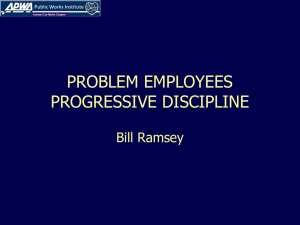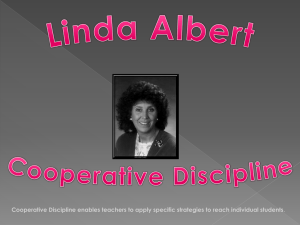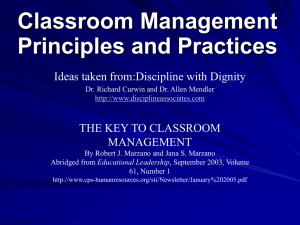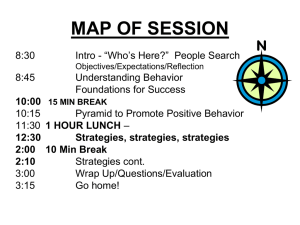OBJECTIVES
advertisement
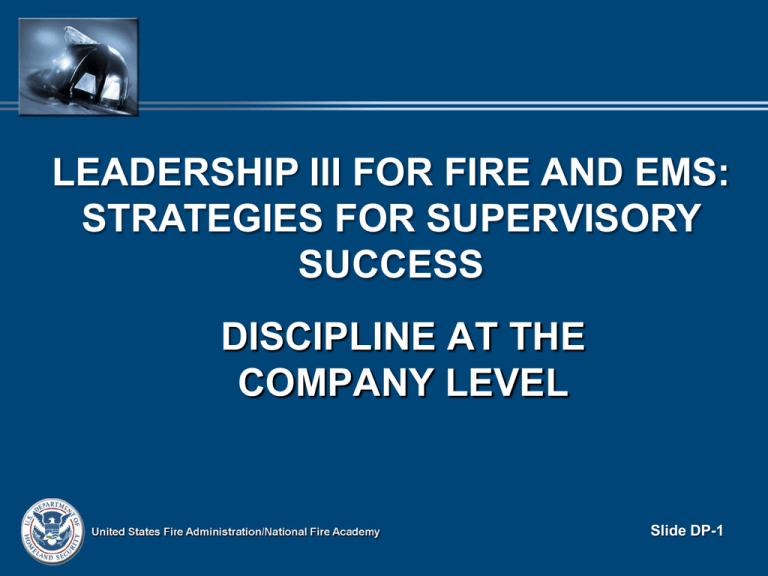
LEADERSHIP III FOR FIRE AND EMS: STRATEGIES FOR SUPERVISORY SUCCESS DISCIPLINE AT THE COMPANY LEVEL Slide DP-1 OBJECTIVES The students will: • Identify the value of positive discipline. • Describe how to use discipline to correct improper employee behavior. • Describe how to apply discipline consistently, fairly, and impartially. • Identify the value of progressive discipline. Slide DP-2 OVERVIEW • • • • • • • • • • Introduction Positive and Negative Discipline Rules and Regulations The Importance of Discipline Common Violations and Actions Progressive Discipline The Disciplinary Interview Bizarre Behaviors Employee Values Final Tips Slide DP-3 INTRODUCTION • The perfect fire department/emergency medical services (EMS): – Perfect set of rules. – Management support. – Employees know appeal procedures. – Rules enforced. – Transferring of problem personnel at the first opportunity never occurs. – Company Officers (COs) trained in discipline. Slide DP-4 INTRODUCTION (cont'd) • Difficulties – Inappropriate/Obsolete rules – Unsupportive administration – Reductions in severity when appealed – Some officers who do not enforce rules – Transferring problem personnel – Untrained Slide DP-5 INTRODUCTION (cont'd) • Definition – Discipline is behavior and order maintained by training and control. – A disciplinary system spells out specific punishments for specific infractions. Slide DP-6 Activity DP.1 Reasons Discipline Is Avoided Slide DP-7 POSITIVE AND NEGATIVE DISCIPLINE • Negative discipline involves: – Punishment, often harsh – Win-lose climates – Interpersonal resentment Slide DP-8 POSITIVE AND NEGATIVE DISCIPLINE (cont'd) Positive approach: • Encourages self-discipline • Disciplinary actions necessary to educate • Lets person know through experience and example what is expected • Aimed at guiding the member • Mildest penalty causing change • Attitude that must be accepted by supervisor as approach and developed in subordinate Slide DP-9 RULES AND REGULATIONS • "Hot stove" theory – Gives you warning – Reacts immediately – Consistent – Impersonal – Doesn't apologize or gloat – Doesn't get emotional Slide DP-10 RULES AND REGULATIONS (cont'd) • Rules are key to effective discipline if: – Thoroughly understood and communicated – Applied equally – Enforced – Written – Needed Slide DP-11 RULES AND REGULATIONS (cont'd) • Failure to follow rules can endanger others. • Rules should be reviewed periodically. – Obsolete rules can cause disrespect. – Obsolete rules weaken control and morale. – COs should work toward changing unfair or obsolete rules. Slide DP-12 THE IMPORTANCE OF DISCIPLINE • To the department – Enhances organizational efficiency and effectiveness – Reinforces departmental values – Reinforces hierarchical relationships – Fosters order, not chaos – Clarifies management's expectations of subordinates – Resolve problems at an early stage – Reduces organizational liability Slide DP-13 THE IMPORTANCE OF DISCIPLINE (cont'd) • To the CO – Provides tools to deal with improper behavior – Increases company efficiency – Provides framework for equitable and fair treatment – Authority to discipline contributes to CO's powerbase – Earns respect – Improves individual subordinate's performance – Increase self-discipline Slide DP-14 THE IMPORTANCE OF DISCIPLINE (cont'd) • To the firefighter/EMT – Provides a certain level of security – Set boundaries – Makes organizational goals clear – Rewards employees for good behaviors – Corrects problems before it's too late Slide DP-15 THE IMPORTANCE OF DISCIPLINE (cont'd) • Bureaucracy ensures fair treatment for all employees by management. – Each employee has specified and official areas of responsibility controlled by rules. – There is a clearly ordered system of supervision and subordination. – Written rules are maintained as a means of managing. Slide DP-16 What are the most common disciplinary problems in a career department? Slide DP-17 COMMON VIOLATIONS AND ACTIONS • • • • • • • • • • Tardiness Absenteeism Abuse of sick leave Insubordination Missed alarms Failure to carry out assignments Sloppy work Sloppy appearance Improper conduct Failure to adequately perform at emergencies Slide DP-18 What are the most common disciplinary problems in volunteer departments? Slide DP-19 COMMON VIOLATIONS AND ACTIONS (cont'd) • • • • • Poor attendance at emergencies Poor attendance at training Poor participation at other departmental functions Poor performance at emergencies Driving private vehicles recklessly while responding to alarms • • • • • Responding to alarms while under the influence of alcohol or drugs Fighting Improper care of equipment Failure to use proper personal protective equipment (PPE) at emergency scenes Insubordination Slide DP-20 What are the similarities and differences between disciplinary problems encountered in career and volunteer departments? Slide DP-21 COMMON VIOLATIONS AND ACTIONS (cont'd) • Common disciplinary actions – Informal discussion is first option – Verbal warning or admonishment -- Usually first attempt to correct minor violations -- Gives employee a chance to correct behavior without a permanent entry in the official record Slide DP-22 COMMON VIOLATIONS AND ACTIONS (cont'd) • Written reprimand – An official action for failure to correct behavior after one or two verbal warnings – Sometimes the initial discipline for more serious violations of rules and procedures – Usually part of employee's official record – Usually recommended by the CO and acted on by the fire/EMS chief Slide DP-23 COMMON VIOLATIONS AND ACTIONS (cont'd) • Fine – Forfeiture of pay – Forfeiture of time – Demotion (if appropriate) – Extra work during the regular duty day – Small fines sometimes used in volunteer organizations – Usually recommended by the CO and acted on by the fire/EMS chief Slide DP-24 COMMON VIOLATIONS AND ACTIONS (cont'd) • Suspension – Given for repeated violations – Given initially for serious violations – Last step before termination – Usually from 1 to 30 days in length – Usually recommended by the CO and acted on by the fire/EMS chief Slide DP-25 COMMON VIOLATIONS AND ACTIONS (cont'd) • Demotion – Temporarily – Permanently Slide DP-26 COMMON VIOLATIONS AND ACTIONS (cont'd) • Termination – After all else fails – Used only if employee cannot be rehabilitated or made to conform to departmental standards or if public safety or health is endangered – Usually recommended by the CO and acted on by the fire/EMS chief Slide DP-27 PROGRESSIVE DISCIPLINE • A positive corrective plan, rather than a negative approach • Proposed punishment should: – Be reasonable – Fit the offense – Become increasingly severe for repeated infractions of the same rule • Process that has greatest potential to correct improper behavior with minimal punishment Slide DP-28 PROGRESSIVE DISCIPLINE (cont'd) • Value: – Minimum punishment – Fair – Required to implement more severe punishment if previous failed – Vital for successful outcome if action is appealed – Gives employees a chance to show they can meet job standards Slide DP-29 PROGRESSIVE DISCIPLINE (cont'd) • Progressive discipline versus "zapping" approach – "Zapping" takes place when you have a marginal employee who is barely performing, yet you're never able to pinpoint a specific punishable offense. Eventually, the employee does something which is punishable and you "zap" with a punishment much greater than is warranted for the specific violation Slide DP-30 PROGRESSIVE DISCIPLINE (cont'd) • • Progressive discipline versus "zapping" approach (cont'd): – "Zapping" is usually an attempt to "get" the employee for all past, unpunished behavior. – Usually overturned upon appeal because punishment doesn't fit infraction -- Also referred to as "Gunny Sacking" COs need to ask themselves two questions in such situations: – Does proposed discipline fit the present violation – Is proposed discipline likely to correct behavior Slide DP-31 TYPICAL ACTIONS CHART Offense First Offense Discipline Second Offense Discipline Third Offense Discipline Suspension (progressive) Tardiness Verbal warning Reprimand Insubordination Suspension Termination Missed alarm Warning/ Suspension Suspension Termination Sloppy work Warning Reprimand/ Suspension Suspension/ Termination Improper conduct Warning/ Suspension Reprimand/ Suspension Termination Violation of safety regulations Warning Reprimand/ Suspension Suspension/ Termination Stealing Suspension/ Termination Termination Fighting Suspension/ Termination Termination Slide DP-32 TYPICAL ACTIONS CHART (cont'd) • Considerations when applying progressive discipline – Prior violations of similar rules – Extenuating circumstances--supervisor must always be fair and impartial – Seriousness of the offense Slide DP-33 THE DISCIPLINARY INTERVIEW • Steps in conducting disciplinary interview – Prepare – State your case – Indicate seriousness – State expectations – Try to get commitment change from employee – End session on positive note – Document your actions – Inform employee of appeal procedures Slide DP-34 THE DISCIPLINARY INTERVIEW (cont'd) • Checklist for successful disciplinary interview – Select proper setting – Listen – Don't interrupt – Don't lose your temper – Don't argue – Stick to the facts – Focus on specific improper behavior Slide DP-35 THE DISCIPLINARY INTERVIEW (cont'd) • Common errors: – Not being clear about violations. -- Is not fair to employee. -- Will not succeed in correcting improper behavior. -- Can damage morale. -- Everyone is a loser. – Improper or no documentation. -- Most cases lost on appeal are due to insufficient or improper documentation. -- Don't make idle threats. Slide DP-36 Activity DP.2 Evaluating Disciplinary Processes Slide DP-37 BIZARRE BEHAVIORS • Behaviors that are unusual in nature and for which there may not be written rules or procedures: – Member shows up for work with large dangling earring and refuses to remove it. – Member shouts abuses at a citizen walking by station. – Member writes obscenities on restroom walls. – Member preaches religious beliefs to owners while on code enforcement. – Member(s) engage in horseplay or practical jokes. Slide DP-38 BIZARRE BEHAVIORS (cont'd) • What is bizarre to one may be normal to another. • COs need to guard against overreacting. • Bizarre behavior checklist: – Damage to equipment or property? – Create unsafe situation? – Correctable? – Violate the law? – Department's image damaged? – Damage morale? Slide DP-39 BIZARRE BEHAVIORS (cont'd) • As CO, you must deal with this type of behavior just as you do with routine disciplinary problems. – Avoid inappropriate reactions. – Make sure your normal procedures are followed. – Advise employee of appeal procedures. Slide DP-40 BIZARRE BEHAVIORS (cont'd) • If there is no specific rule in place, consult management. Management should: – Determine policy – Transmit policy – Enforce new policy – Continue disciplinary actions even if it is felt the actions will be reversed on appeal Slide DP-41 BIZARRE BEHAVIORS (cont'd) • In many cases involving inexperienced supervisors or managers, termination is their primary reaction to any type of bizarre behavior. These inappropriate reactions are almost always lost when appealed. • The CO should seek advice from superiors when dealing with any type of bizarre behavior. Slide DP-42 EMPLOYEE VALUES • Wouldn't it be wonderful if all employees had: – Proper attitude – Willingness to work – Commitment to departmental goals • They don't! There will always be some: – Undisciplined personnel – Incompetent personnel – Personnel who won't do the work expected of them Slide DP-43 EMPLOYEE VALUES (cont'd) • Three types of subordinates: – Employee with positive self-imposed discipline – Employee with goals and values that don't match organization – Will not adapt to department's goals and values Slide DP-44 EMPLOYEE VALUES (cont'd) • Don't ignore problems. – Don't let improper behavior slide--take action. – Be sure you inform employee that a rule has been violated as soon as it occurs. • Most marginal employees can be coached and motivated into becoming productive employees. Slide DP-45 Activity DP.3 Determining Proper Discipline Slide DP-46 FINAL TIPS • • • • • • • • • Cardinal Rule #1: Praise in public; criticize in private. Treat every case as if it will be appealed. When discipline is given, it is over. Don't keep referring to someone's mistakes. Apply discipline consistently, fairly, and impartially. Deal with behavior, not personality. Never discipline when you are angry. Reinforce good behavior. Set a good example. Don't "save up" discipline--act as soon as possible. Slide DP-47 FINAL TIPS (cont'd) • • • • • • Don't threaten punishment you cannot deliver. If you suspect substance abuse, get help from chief's office. If in doubt on any disciplinary action, ask the chief's office. Don't play games with union by giving too much discipline, figuring it will be reduced when appealed. Don't transfer your problems; solve them. Be familiar with union contract's grievance procedures and employee rights. Slide DP-48 FINAL TIPS (cont'd) • Know your rules and regulations thoroughly • Be willing to treat an honest mistake as an honest mistake. Slide DP-49


